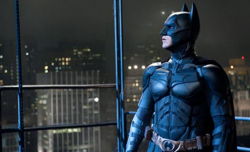Why There?
We can’t blame The Dark Knight Rises for the Aurora shooting. But we also can’t ignore the parallels between Christopher Nolan’s grim world and our own.

Photograph by Ron Phillips.
The scene is almost unimaginable in its terror, and in a horrible way, cinematic: In a crowded movie theater at midnight, a man dressed in black, wearing a gas mask and carrying multiple firearms, bursts through a door, first throwing a canister full of noxious gas and then firing randomly into the crowd. The murder and chaos taking place onscreen leaps, impossibly, out of the fictional universe and into the real one. What would have been happening in the movie at that moment? It was 10 or 15 minutes in, eyewitnesses say—had the villain of The Dark Knight Rises, the masked, black-clad terrorist Bane, already launched his terror campaign against Gotham, or did his initial assault on the city coincide exactly with that of James Holmes on the Century 16 theater in Aurora, Colo.?
It’s only been a few hours since most of us heard about the mass shooting at a midnight screening of The Dark Knight Rises, and the news about the event is still scattered and confusing: eyewitness cellphone videos, police-scanner audio, and casualty counts that remain under revision. But we know that a 24-year-old white man from San Diego decided it was a good idea to arm himself to the teeth, dress like a paramilitary vigilante (again, the details are still hazy, but I’ve seen mention of camouflage pants, a bulletproof vest, a riot-gear helmet) and go kill 12 people in a multiplex, wounding 59 more.
“Don’t blame the movie,” reads a sober post at Indiewire, and at The New Yorker, Anthony Lane reminds us that, however tempting it may be to draw parallels between the actions of the shooter and the murderously anarchic villains of the last two Batman movies, “no film makes you kill.” They’re right, of course. Remember all those infuriating, sententious op-eds about the pernicious power of video games in the wake of the Columbine school shootings, as if prying the joysticks out of American teenagers’ hands was more urgent than prying away their guns? Positing a direct causal relationship between the representation of violence and its real-life manifestation is reductive and, ultimately, lazy—it gives us an excuse to wring our hands about moral decay and cultural decadence while ignoring the practical policy decisions that enabled the horrors of Columbine and now Aurora (two Colorado towns whose pretty names—the flower, the dawn—will now ring permanently hollow).
But this isn’t a think piece, it’s a feel piece, a quick, instinctive burst of anger and revulsion and despair at this morning’s news. And in between asking why? (we’ll never know, probably) and how? (that one’s easy—if you want to shoot people in America you can always find a way) I can’t stop asking a third question: why there? I can’t get away from the fact that this act of violence took place—with, from the look of it, considerable advance planning—at an opening-night midnight showing of The Dark Knight Rises, a movie that (like the rest of the trilogy it concludes) envisions modernity as a lawless dystopia where just such a thing might happen. In Christopher Nolan’s pitch-black vision, no communal cultural event is safe from potential invasion by marauders: The movie’s most spectacular action scene involves a packed stadium of football fans watching in horror as Bane and his army blow the field and everyone on it sky-high.
Alyssa Rosenberg writes movingly of how shocking it is to imagine the space of the movie theater turning, in an instant, into a place of terror and death: “We are vulnerable when we go to the movies, open to fear, and love, and disgust, and rapture, surrendering our brains and hearts to someone else’s vision of the world.” But what about when the vision we choose to surrender ourselves to is, precisely, one of a world ruled by vigilante violence and random acts of terror? Nolan’s Batman trilogy has proceeded on the assumption that what happens on the screen in some way reflects what’s happening in the world, that fantasy and reality are mutually permeable—this is what makes his movies function as political allegories, if at times muddled ones. Why shouldn’t we assume the reverse is true as well—that the grim, violent fantasies we gather to consume as a culture have some power to bleed over from the screen into real life?
I’m not suggesting that the young men of America are being brainwashed by Christopher Nolan into going on Bane-style killing sprees. Nor am I arguing for censorship or bowdlerization or any increased degree of interference with the content of entertainment. But James Holmes didn’t burst into a screening of Happy Feet Two. To discuss the meaning and motives of his crime, of course we have to at least talk about why he might choose The Dark Knight Rises as a backdrop (and possibly a template) for whatever private fantasy he was enacting. And maybe there should also be conversations about what it means that the economics of the film industry are driven almost entirely by the fantasies and desires of young men, and what effect that kind of over-representation in pop culture might have on … the fantasies and desires of young men. All I know is that, when I heard the news about the Aurora shootings, my first thought was very clear and very scary: “Of course this was going to happen sooner or later.”
See Photos From the Aurora, Colo. Movie Theater and the Shooting Suspect's Home:
